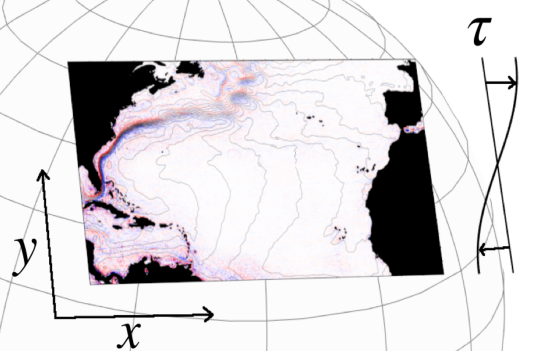Two-Dimensional Simulation Captures the Ocean’s Energy Cycle
Liquid flowing in two dimensions in a square basin is a poor imitation of the North Atlantic Ocean, but this setup can capture important aspects of the ocean’s turbulent flow, according to new simulations [1]. The researchers found that their model is able to account for the ocean’s energy dissipation—the conversion of kinetic energy into heat—which has not been possible with previous two-dimensional (2D) simulations without adding ad hoc assumptions. According to the model, friction between the ocean and the continental coastlines generates vortices that can dissipate a significant amount of energy. The results suggest that this simple model may provide more information than researchers previously expected about the energy cycle in the ocean.
Ocean simulations in 2D can’t provide the detailed information of those in 3D , but they can provide general insights and are available to many more researchers. A traditional 2D simulation of an ocean basin includes the effects of the prevailing winds and of Earth’s rotation (the Coriolis force), which together drive the large-scale circulation pattern observed in the North Atlantic and other ocean regions. But there’s a problem with these simulations: when the viscosity is set to a small value—close to its near-zero value in the real ocean—the kinetic energy of the fluid increases without limit. To avoid this runaway energy, researchers add a dissipation term into the equations to account for 3D effects such as friction with the ocean floor.
Previous work suggested another way to produce significant dissipation: imposing a “no-slip” condition at the fluid boundary—essentially, creating friction between the fluid and the wall [2]. Applying this idea to an ocean context, Antoine Venaille of the École Normale Supérieure de Lyon, France, and his colleagues included a no-slip condition in high-resolution simulations, revealing a highly turbulent regime that eliminates the need for the extra dissipation term. The team now plans to explore the properties of the turbulent regime and determine which aspects of the ocean can be studied with their simple model.
–David Ehrenstein
David Ehrenstein is a Senior Editor for Physics Magazine.
References
- L. Miller et al., “Gyre turbulence: Anomalous dissipation in a two-dimensional ocean model,” Phys. Rev. Fluids 9, L051801 (2024).
- R. Nguyen van yen et al., “Energy dissipating structures produced by walls in two-dimensional flows at vanishing viscosity,” Phys. Rev. Lett. 106, 184502 (2011).





